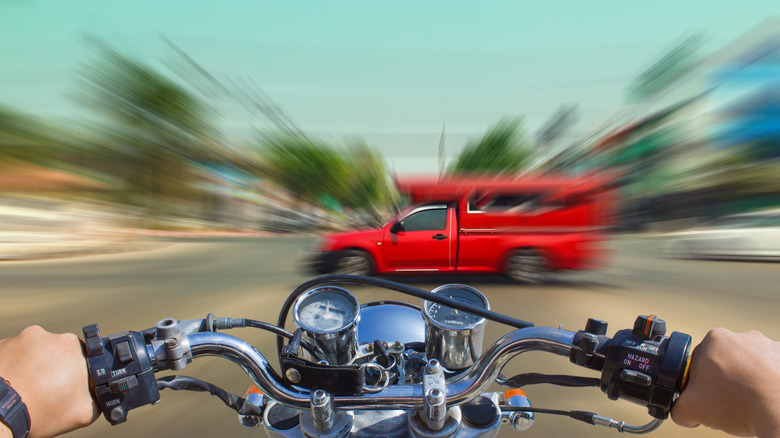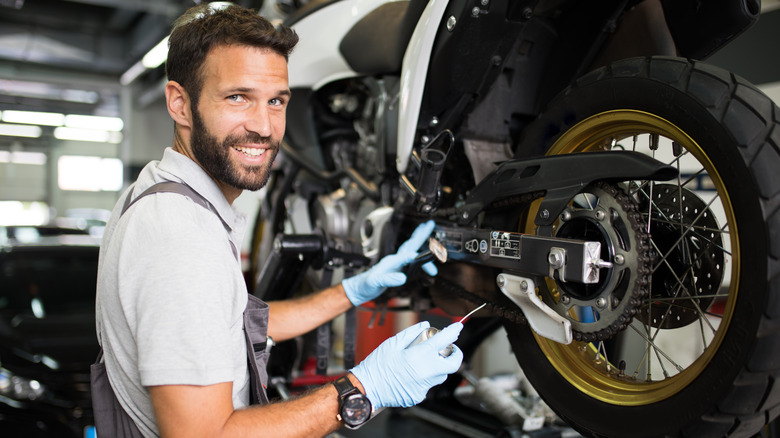What Causes Motorcycle Death Wobble, And How Can You Fix It?
The motorcycle death wobble is as bad as it sounds. You don't throw the word "death" into a bit of terminology just for kicks. Also known as speed wobble, a tank slapper, or headshakes, this physics phenomenon happens when the bike's front wheel oscillates from side to side and subsequently causes the handlebars to shake violently.
A bike's instability can happen anytime and for many reasons, including a motorcycle malfunction or simply from how the bike is being ridden (aka rider error). It can also crop up after hitting a pothole or accelerating too fast, both of which can cause the front wheel to pop off the ground. Regardless of what actually causes it, the feeling is utterly terrifying.
Every type of vehicle — whether it be on land, sea, or air — has the potential to become unstable, and motorcycles have three fundamental instabilities. First is what's called "overturn mode," which is just a fancy term for trying to keep a two-wheeled beast (bicycle or motorcycle) upright while first learning to ride. Remember as a kid thinking that trashing the handlebars back and forth would help keep the bicycle balanced? Yeah, not so much, right?
The remaining two instabilities are both predicated on and directly tied into what a "cycle" is at its core. As Cycle World notes, motorcycle wheels are really just "a pair of casters joined at a common pivot."
Wobble and what causes it to happen
These self-centering caster wheels follow the direction of motion and trail behind a pivot point. If we're being honest, they're fundamentally similar to the horrible, floppy wheels (casters) you find on every grocery store shopping cart, which can and do (albeit more frequently) generate an oscillation and are probably nothing like Caper's AI-powered smart grocery carts.
Motorcycles have a front and rear section and thus have two different types of caster oscillations. The front caster (wheel) gets "wobble," a rapid oscillation of 8–10 cycles per second, and can happen at slow speeds between 35 and 40 mph, but more often than not occur at higher speeds over 75 mph. Meanwhile, the rear caster can develop a side-to-side weave (2–3 cycles per second), otherwise known as fishtailing.
Oscillation develops when something knocks the wheel (caster) from its center position. Since adding weight to either section directly affects its wiggle rate, a bike can be disrupted by speed (especially when cornering), uneven tire wear, improperly inflated tires, an incorrectly adjusted swingarm, or excessive side-to-side or lateral axle movement (sometimes created by bad wheel bearings).
Should the wheel leave the road, this castor/pivot design is supposed to get it back into a straight line even if it hits the ground at an angle, but sometimes getting the forks back in alignment takes so much force that the rider over-corrects and causes the handlebars to flail wildly.
How to fix a death wobble
Riders should always keep their motorcycle finely tuned and in good working order. As we've outlined, mechanical issues can be just as much a cause of a death wobble as bad luck, so it's important to be aware of all the tips for motorcycle maintenance. Additionally, knowing precisely how your motorcycle feels and behaves when it's empty versus when you're carrying a passenger (or some other load) is vital.
If you've done all those things but still find yourself staring down the barrel of a death wobble, you must stay calm and resist the urge to panic. Keep a firm grip on the handlebars (but not too tight), and don't fight the bike. Remember, the pivot/caster design will auto-correct if nothing upsets its center position or the chassis.
Despite initial instincts, don't apply the front brake as it will shift more weight to the front wheel, which will only destabilize it more. In fact, some sources claim you shouldn't even apply the brakes as it will only worsen the issue, but progressively using the rear brake will slow down the bike, and as it slows, the wobble rate will decrease. Other sources say riders who successfully navigated a death wobble hit the throttle slightly to straighten the bike, but sometimes you don't have the requisite space or mental wherewithal.
Lastly, while this might seem like a no-brainer, riding safely will avoid a death wobble. Popping wheelies, tearing through turns, or anything else that might cause one to lose control is just tempting fate.

